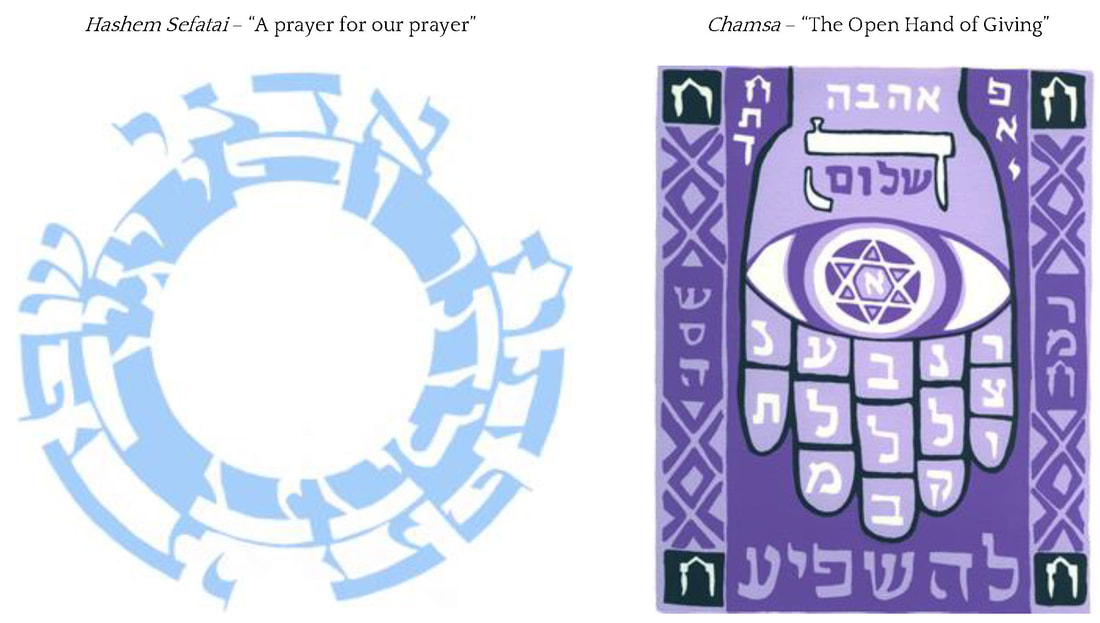Return to Newsletter main page! |
Expanding Your Students' Hebrew PaletteBy ISJL Education Fellow Julia Kunis
Do you see this here? It’s the 22 letters in the Hebrew alphabet! Visually, Hebrew is a fascinating language, right? With all of its lines, curves, dots, and air of mystery, it is perhaps a work of art in and of itself. Using Hebrew in works of art is not a new concept. In fact, it has pervaded throughout homes and synagogues for centuries. But, what if the use of Hebrew in works of art could enhance the learning experience in the classroom? And, potentially, inspire students to dive a little deeper into their Judaism? Through the use of Hebrew in art work, we give students yet another medium by which they can engage with their Judaism. As we know, engaging students in learning Hebrew is a constant process that takes time and commitment. The pieces we will look at are meant to engage and provide students with a new perspective and platform to learning Hebrew and learning a little more about Judaism. Avraham Loewenthal is one of many artists that lives in Israel. His artwork combines Jewish mysticism and contemporary art to express spiritual concepts of kabbalah (Jewish mysticism). Several of his art pieces portray the use of Hebrew to explain deeper spiritual concepts in Judaism, inspired by kabbalah. You may be wondering: how the hamantaschen can I bring such large and abstract concepts into my classroom? And, what will it do for my students? Well, let us take a deeper look into two of Avraham Loewenthal’s pieces and find out how. “Hashem Sefatai – A Prayer for Our Prayer” The piece, titled “Hashem Sefatai,” the opening portion of the amidah (“standing prayer” which opens with “God, may my lips open and my mouth speak your praise”) is arranged in a circle with blue Hebrew lettering. Now, imagine that you are a young student just about to learn the amidah. You see that your teacher puts this piece of artwork on the board. Sure, you as the student may think that this is another lecture you would have to sit through—another prayer to learn. But, what if your teacher started showing you that this piece of art is not just blue Hebrew letters arranged in a circle? Actually, the circle you see symbolizes unity and oneness, reflective of the unity with God; and this portion of the amidah depicted, is whispered, and is considered to be a “prayer for our prayer.” In actuality, this artwork is a (mystical) journey that employs Hebrew to dive deeper into the values and concepts of Judaism. As the teacher starts to explain and connect more and more, students are taken on a journey throughout the piece, but you start to become more interested in what it is that you are learning. By analyzing this piece of artwork with students the overall intention is to use this artwork as a medium is to inspire more engagement in the class with Hebrew. In addition, you are setting a solid foundation for students to be taken on a journey through the beginning stages of, in this case, the Amidah. You are showing them another way to connect deeper with Judaism and their faith. “Chamsa – The Open Hand of Giving” In our second piece, titled “Chamsa,” we see an open hand (represented as the hand of giving), with an eye in the center of the hand (representing the good in everything). Within and without this hand, there is Hebrew (and deeper meanings!) to engage students. For example, at the top of the piece it is written ahava (love) and shalom (peace). Between these two Hebrew words there is the Hebrew letter hei, which represents the divine presence. Learning that ahava means “love” in Hebrew and that shalom means “peace,” and seeing that these two words surround the hei of the divine presence, speaks volumes. By connecting Hebrew to a tangible concept that love and peace are divine, the artist tells us that when we give love and peace we can experience the divine. By introducing artwork with Hebrew, like Avraham Loewenthal’s, students can have an opportunity to learn and connect with Hebrew and deeper concepts in Judaism that gives them the platform to continue engaging and learning. There is tons more to unpack and discover when looking at Avraham Loewenthal’s artwork. In the religious school classroom, using artwork like Loewenthal’s gives students an opportunity to delve into the meanings and values in Judaism, and it sets them up with an engaging platform that looks at Hebrew through a different lens. I’ll leave the rest of the unpacking and discovering up to you and your class. |
- Home
- WHO WE ARE
-
WHAT WE DO
- PODCAST
- Conference >
- Education >
-
CULTURE
>
- Culture Overview
- Cultural Programming >
-
History
>
-
Encyclopedia of Southern Jewish Communities
>
- Alabama Encyclopedia
- Arkansas Encyclopedia
- Georgia Encyclopedia
- Florida Encyclopedia
- Kentucky Encyclopedia
- Louisiana Encyclopedia
- Mississippi Encyclopedia
- North Carolina Encyclopedia
- Oklahoma Encyclopedia
- South Carolina Encyclopedia
- Tennessee Encyclopedia
- Texas Encyclopedia
- Virginia Encyclopedia
- Encyclopedia Credits
- Oral History
-
Encyclopedia of Southern Jewish Communities
>
- SPIRITUALITY >
- DONATE
- Shalom Y'all
- Strategic Plan
- Southern & Jewish Blog
- Calendar
- Virtual Press Kit
|
©2024 Goldring/Woldenberg Institute of Southern Jewish Life
|

